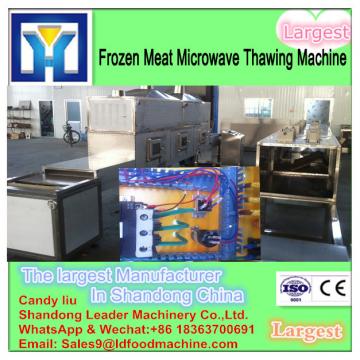Microwave Tunnel Thawing machine has a fast sterilization speed and a short time. The traditional sterilization method relies mainly on heating. The heat is transmitted to the interior through the surface of the food through conduction, convection or radiation.
The Microwave Thawing machine transfer rate depends on the heat transfer characteristics of the food, thus causing the surface and center of the food. The difference in temperature thus extends the total time required for food sterilization. However, the microwaved material directly absorbs the microwave energy during the microwave treatment, Microwave machine and uses the transmission effect to combine the thermal effect and the non-thermal effect to make the food uniform and rapid, to rapidly heat up, kill the microorganism, and the processing time is greatly shortened.
2. 2 Maximize the nutrition and flavor of foods The nutrients and aromatic substances of meat products are easily disintegrated under high temperature. The traditional sterilization methods are caused by long heating time and high temperature, and the nutrients and flavor substances are destroyed. In contrast, microwave energy can achieve the desired bactericidal effect at a lower temperature and in a shorter period of time. Generally, the sterilization temperature can be achieved at 75 to 80 ° C, thereby retaining more nutrients, color, fragrance, Taste, shape, etc.
2. 3 Sterilization is even and thorough, energy-saving and efficient. When microwave sterilization, regardless of the shape of each part of the object, microwaves treat 150, 600g and 1 500g of beef with microwaves of 713W and 356W respectively. As a result, it was found that the sterilizing effect was the same as long as the microwave dose (power × treatment time/weight) was the same regardless of the microwave power and the amount of treatment. The microwave dose correlates well with the bactericidal effect and temperature, which means that microbial power, processing time and temperature can be used to predict microbial growth.
Leader Machine inoculated spores of Bacillus cereus and Clostridium perfringens in unknown concentrations into the minced meat samples and treated them in a microwave oven. The results showed that the number of spores of Bacillus cereus decreased with the increase of microwave treatment time. However, it was not completely killed, and the number of spores of Clostridium perfringens showed a decrease and then increased with the increase of microwave treatment time. The Leader Machine study found that the combined application of gamma rays and microwaves can extend the shelf life of beef products with a low impact on the flavor of meat products. Using a microwave treatment of E. coli and Bacillus subtilis, Leader Machine found that as cells release DNA and protein during warming, the number of viable cells decreases as the amount of DNA and protein released increases, but the density of cells does not change significantly.
leader machine used a microwave oven to sterilize beef samples inoculated with E. coli O157:H7 and determined bacterial survival rates at different sterilization times and bactericidal strengths. The results showed that at 30, 60, 90, and 120 s of microwave intensity at 70%, 80%, 90%, and 100%, the effect of microwave on bacteria was obvious (p < 0.005), and the number of bacteria in the sample was The sterilization time and temperature increase and decrease. Leader Machine sterilizes several heat-resistant spores with different power microwaves under different salt concentrations, starch content and packaging containers. It was found that B. licheniformis was most resistant to microwaves at different times of treatment at 100% microwave power. Leader Machine will be 10cells/mL under aseptic conditions
Microwave sterilization is a sterilization method that is very adaptable.
Microwave equipment can be used in a variety of food systems such as powdered materials, paste materials, liquid materials and solid materials. This is not possible with many other sterilization methods. Sterilization is a very important operation in the processing of meat products. Microwave sterilization can be applied to various food processing such as meat products, which can shorten the sterilization time, facilitate the continuous production, and has less equipment and easy operation. It is a sterilization process worthy of vigorous development. However, there are relatively few studies on the mechanism of microwave sterilization. Some studies believe that there is no non-thermal effect in microwave sterilization. In fact, the non-thermal effect is still very important in the microwave sterilization process, just because the research system and the object are different. No non-thermal effects of microwaves were observed during these studies, but the non-thermal effects of microwave sterilization could not be denied.




